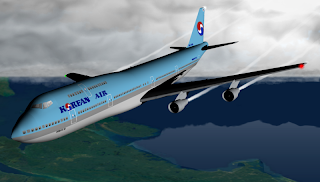CG render of 747-3B5 HL7468
Korean Air Flight 801
Korean Air Flight 801
"Blind Landing"
The korean air Boeing 747-3B5 airliner flew on a route Seoul, South Korea to Guam. It carried 2 pilots, 1 flight engineer, 14 flight attendants, and 237 passengers, a total of 254 people on board. Of the 3 passengers were children between the ages 2 and 12 and 3 were 24 months old or younger.
The flight, headed by Captain Park Yong-chul and First Officer Song Kyo-Ho, was uneventful until shortly after 1:00 a.m. on August 6, as the jet was preparing to land. There was heavy rain at Guam so visibility was significantly reduced and the crew was attempting an instrument landing. However, air traffic control in Guam advised the crew that the glideslope Instrument Landing System (ILS) in runway 6L was out of service. Nevertheless, air traffic control cleared Flight 801 to land in runway 6L at around 1:40a.m. The crew noticed that the plane was descending very steeply, and noted several times that the airport "is not in sight". At 1:42, the aircraft crashed into Nimitz Hill, about 3 miles (5 km) short of the runway, at an altitude of 660 feet (201 m). Of the people on board, 223 people, including 209 passengers and 14 crew members (3 flight crew and 11 cabin crew) were killed at the crash site. Of the 31 occupants found alive by rescue crews, 2 passengers died en-route to the hospital and 3 other passengers died within 30 days. One of the two passengers that died en-route to the hospital, a female, sustained multiple internal injuries and had no burns and no soot in her airway, leading autopsy to classify her death as not of any one cause. Upon discovery she was alive and treated by rescuers. 23 passengers and 3 flight attendants survived the crash with serious injuries. Of the survivors, 7 passengers and 1 flight attendant were in first class, 1 flight attendant was in the prestige class section, 7 passengers were in the forward economy class section, and 9 passengers and 1 flight attendant were in the aft economy section. 13 of the surviving passengers and 2 of the surviving flight attendants were seated in the right side of the airplane, and 6 of the 13 passengers were seated over the right wing. The rescue effort was hampered by the weather, terrain, and other problems. Emergency vehicles could not approach due to a fuel pipeline destroyed by the crash and blocking the narrow road. There was confusion over the administration of the effort; the crash occurred on land owned by the US Navy but civil authorities initially claimed authority. The hull had disintegrated, and jet fuel in the wing tanks had sparked a fire which was still burning eight hours after impact. The U.S. National Transportation Safety Board investigation report stated that the Minimum Safe Altitude Warning (MSAW) system had been deliberately modified and would not detect the plane that close to the runway. The captain failed to brief his non-precision approach and prematurely descended to decision height. Contributing to the accident were the captain's fatigue, Korean Air's lack of flight crew training, as well as the intentional inhibition of the Guam ILS. The crew had been using an outdated flight map, which stated that the Minimum Safe Altitude for a landing plane was 1,770 feet (540 m) as opposed to 2,150 feet (656 m). Flight 801 had been maintaining 1,870 feet (570 m) when it was waiting to land.


No comments:
Post a Comment